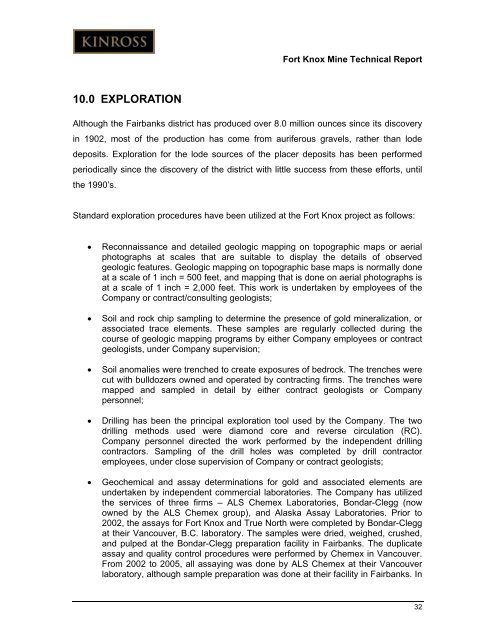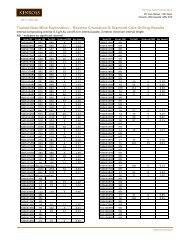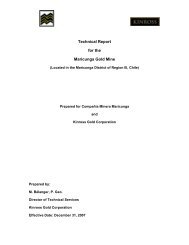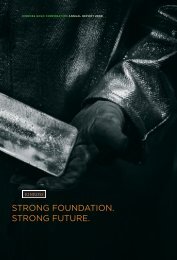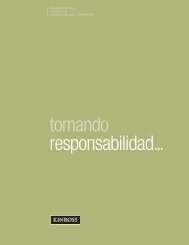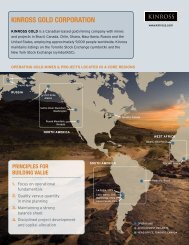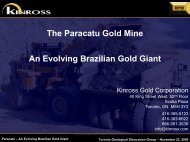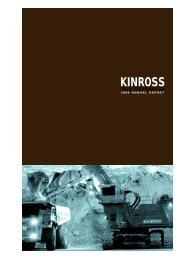Technical Report for the Fort Knox Mine - Kinross Gold
Technical Report for the Fort Knox Mine - Kinross Gold
Technical Report for the Fort Knox Mine - Kinross Gold
You also want an ePaper? Increase the reach of your titles
YUMPU automatically turns print PDFs into web optimized ePapers that Google loves.
<strong>Fort</strong> <strong>Knox</strong> <strong>Mine</strong> <strong>Technical</strong> <strong>Report</strong>10.0 EXPLORATIONAlthough <strong>the</strong> Fairbanks district has produced over 8.0 million ounces since its discoveryin 1902, most of <strong>the</strong> production has come from auriferous gravels, ra<strong>the</strong>r than lodedeposits. Exploration <strong>for</strong> <strong>the</strong> lode sources of <strong>the</strong> placer deposits has been per<strong>for</strong>medperiodically since <strong>the</strong> discovery of <strong>the</strong> district with little success from <strong>the</strong>se ef<strong>for</strong>ts, until<strong>the</strong> 1990’s.Standard exploration procedures have been utilized at <strong>the</strong> <strong>Fort</strong> <strong>Knox</strong> project as follows:• Reconnaissance and detailed geologic mapping on topographic maps or aerialphotographs at scales that are suitable to display <strong>the</strong> details of observedgeologic features. Geologic mapping on topographic base maps is normally doneat a scale of 1 inch = 500 feet, and mapping that is done on aerial photographs isat a scale of 1 inch = 2,000 feet. This work is undertaken by employees of <strong>the</strong>Company or contract/consulting geologists;• Soil and rock chip sampling to determine <strong>the</strong> presence of gold mineralization, orassociated trace elements. These samples are regularly collected during <strong>the</strong>course of geologic mapping programs by ei<strong>the</strong>r Company employees or contractgeologists, under Company supervision;• Soil anomalies were trenched to create exposures of bedrock. The trenches werecut with bulldozers owned and operated by contracting firms. The trenches weremapped and sampled in detail by ei<strong>the</strong>r contract geologists or Companypersonnel;• Drilling has been <strong>the</strong> principal exploration tool used by <strong>the</strong> Company. The twodrilling methods used were diamond core and reverse circulation (RC).Company personnel directed <strong>the</strong> work per<strong>for</strong>med by <strong>the</strong> independent drillingcontractors. Sampling of <strong>the</strong> drill holes was completed by drill contractoremployees, under close supervision of Company or contract geologists;• Geochemical and assay determinations <strong>for</strong> gold and associated elements areundertaken by independent commercial laboratories. The Company has utilized<strong>the</strong> services of three firms – ALS Chemex Laboratories, Bondar-Clegg (nowowned by <strong>the</strong> ALS Chemex group), and Alaska Assay Laboratories. Prior to2002, <strong>the</strong> assays <strong>for</strong> <strong>Fort</strong> <strong>Knox</strong> and True North were completed by Bondar-Cleggat <strong>the</strong>ir Vancouver, B.C. laboratory. The samples were dried, weighed, crushed,and pulped at <strong>the</strong> Bondar-Clegg preparation facility in Fairbanks. The duplicateassay and quality control procedures were per<strong>for</strong>med by Chemex in Vancouver.From 2002 to 2005, all assaying was done by ALS Chemex at <strong>the</strong>ir Vancouverlaboratory, although sample preparation was done at <strong>the</strong>ir facility in Fairbanks. In32


